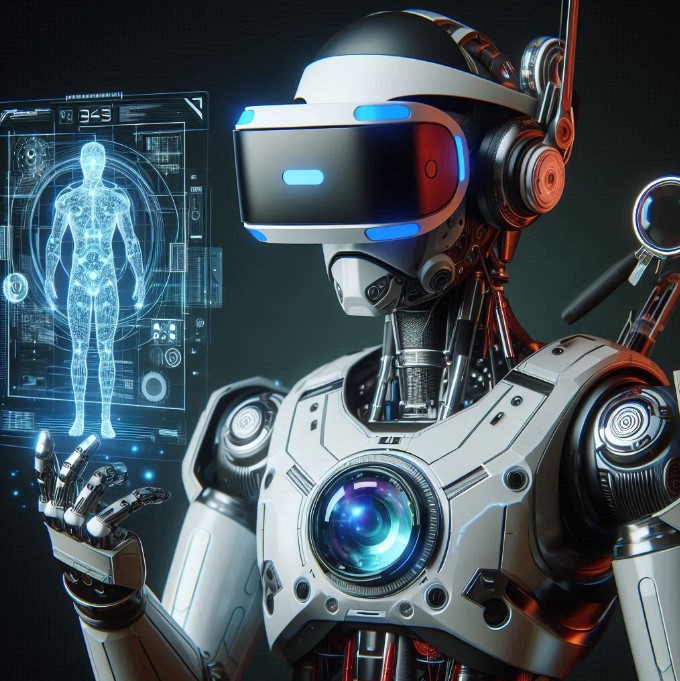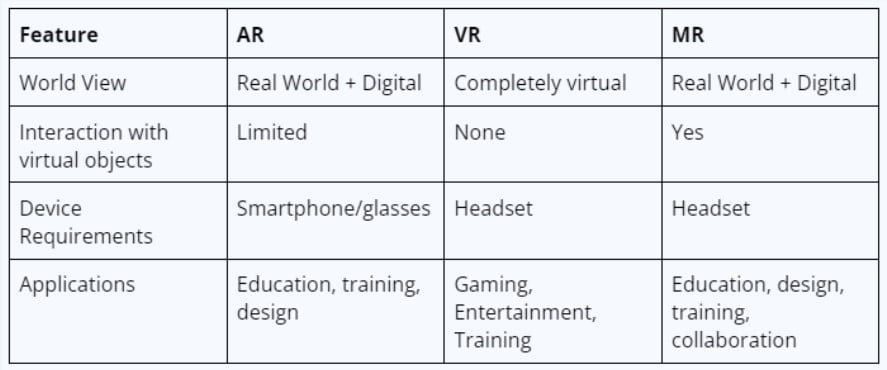Introduction
The world of XR, or Extended Reality is where you can mix the real world with video games or have a virtual coach appear right in your living room! It’s a fancy term for tech that blends the physical and digital.
XR comes in a few flavours: AR (Augmented Reality) adds digital stuff to your real-world view, like showing furniture in your room before you buy it. VR (Virtual Reality) is all-in, transporting you to completely digital worlds. And then there’s MR (Mixed Reality), the in-between zone where virtual objects hang out in the real world, ready to interact with.
Here’s the exciting part: AI, or Artificial Intelligence, is becoming best buds with XR.
AI is the super-smart brain behind XR. It can make AR glasses recognise objects and give you instant info, or create virtual coaches in MR who can guide you through anything. Basically, AI is taking XR from “cool tech” to “mind-blowing experiences.”
In addition, the size of the extended reality market is projected to be USD 105.58 billion in 2024 and USD 472.39 billion by 2029, with a compound annual growth rate (CAGR) of 34.94% from 2024 to 2029 (Mordor Intelligence, 2024).
We’re talking about revolutionising education, design, even entertainment! So, buckle up, because, with AI powering XR, the future is about to get seriously awesome.

Understanding the XR Landscape
XR encompasses a spectrum of technologies that blur the lines between the physical and digital worlds. Let’s explore the three main players in this exciting space:

Augmented Reality
Picture yourself receiving turn-by-turn directions superimposed on your current view, or visualising 3D dinosaurs prowling around your living room. That is how augmented reality works. It seamlessly overlays digital information onto the physical world you see through your smartphone or AR glasses.
Here’s some interesting data - with a market valuation of USD 31.97 billion in 2019, the AR market is projected to grow at a CAGR of 31.5% from USD 42.04 billion in 2023 to USD 375.90 billion by 2031 (SkyQuest Technology, 2024).
Virtual Reality
Strap on a VR headset and prepare to be transported! VR creates a completely immersive, computer-generated environment. Imagine exploring the pyramids of Egypt or scaling Mount Everest - all from the comfort of your couch.
Additionally, the size of the global VR market was projected to be USD 59.96 billion in 2022 and is projected to increase at a CAGR of 27.5% from 2023 to 2030 (Grand View Research, 2024).
Mixed Reality
MR strikes a balance between AR and VR. It projects virtual objects into the real world, but unlike AR, these objects can interact with their surroundings. Think of a virtual toolbox appearing in your garage, allowing you to manipulate virtual tools and learn how to fix things.
For those who enjoy numbers, the 2023 Global Mixed Reality Market Size was estimated to be worth USD 4.02 billion. From 2023 to 2033, the market is expected to grow at a CAGR of 44.39%. By 2033, the estimated size of the global mixed reality market will be USD 158.37 billion. The forecast period is expected to see the fastest growth in Asia Pacific (Spherical Insights, 2024).
Benefits and Limitations:
Each XR technology offers unique advantages. AR enhances real-world experiences with added information, making it ideal for education, training, and design. VR excels at creating immersive simulations for training or entertainment. MR combines the best of both worlds, fostering interactive learning and design applications.
However, there are limitations. AR and MR require specialised devices like glasses or headsets, which might not be readily available or cost-effective. VR can cause motion sickness in some users, and the user experience can be limited by current technology.

As you can see, each XR technology caters to different needs. The future lies in pushing these boundaries and exploring how AI can further enhance these experiences.
The AI Revolution in XR
Core AI Techniques for XR Enhancement
Ever wished your AR glasses could identify objects around you and display relevant information on the spot? Or how about an MR training program that tailors its guidance to your real-time mistakes? This isn’t science fiction; it’s the power of AI in XR. Here’s how these clever techniques are transforming the game:
Computer Vision
This AI powerhouse acts like eyes for AR/MR. It analyses the real world through camera feeds, allowing AR glasses to recognize objects, surfaces, and even lighting conditions. This real-time understanding is crucial for seamlessly integrating virtual elements into the physical world.
For example, with computer vision, an AR app might recognize a specific plant in your garden and display its watering needs or offer care tips. It’s like having a pocket botanist at your fingertips!
Generative AI
Step into a virtual world where anything you can dream of becomes a reality. That’s the potential of Generative AI. This technology can create stunningly realistic 3D objects, environments, and even characters.
In VR, Generative AI crafts breathtaking landscapes for immersive experiences, while in AR, it generates lifelike furniture models you can virtually place in your room before making a purchase.
GPU Acceleration
Bringing AI and XR together requires serious processing power. This is where GPUs, or Graphics Processing Units, come in. GPUs are like super-charged calculators specifically designed for complex graphics rendering. With GPU acceleration, AI algorithms can process information and generate visuals much faster, ensuring smooth and seamless experiences in AR and VR.
Think of it like the difference between a slideshow and a high-definition video. GPUs make sure your AI-powered XR experience is as smooth and realistic as possible.
AI Applications in AR and MR

Remember textbooks and those bulky prototypes that never seemed quite right? XR with AI is here to blow them out of the water, turning learning and design into a mind-blowing playground. Buckle up, because these technologies are about to level up your world in ways you never thought possible!
1. Your Pocket Speech Coach
Imagine practising a presentation and having a virtual Tony Robbins whispering tips in your ear. Or chilling in a VR cafe with a language tutor correcting your pronunciation on the spot! That’s the magic of AI-powered speech training in XR.
Nervous about a big presentation? No worries! Practice in an AR environment where AI analyses your speech, highlights areas for improvement, and gives you personalised feedback. Mastering a new language? Hang out with your AI tutor in a cool VR cafe setting – conquer your stage fright and become a language whiz, all thanks to the power of AI in XR.
2. Learning Gets Lit with AI-powered AR/MR
Textbooks were SO last year! AI-powered AR/MR is here to make learning interactive and, dare we say, awesome. Imagine dissecting a 3D frog in biology class with an AI overlay highlighting all the cool organs in crazy detail. Or practising engineering by manipulating virtual objects with an AI guide whispering assembly tips in your ear. This is learning 2.0 – way more engaging, way more fun, and guaranteed to boost your knowledge retention.
3. Design Like a Pro with AI-powered AR/MR
Tired of flat sketches and clunky prototypes that leave you scratching your head? AI in AR/MR is about to transform design workflows. Imagine using AR glasses to virtually place furniture in your room, with AI analysing how you interact with it in real time. This valuable feedback loop allows designers to create products that are not only functional but also user-friendly.
So, you’re an architect? Imagine using AR to visualise a building on a specific site before even laying a foundation. Or a product developer? Test a prototype virtually before going into production. AI-powered design tools in AR/MR are poised to be a game-changer across various design industries.
4. Object Recognition Gets Crazy with AI
Ever wished your phone could tell you the history of that cool building you just passed? Or maybe you want to virtually place a new fridge in your kitchen to check if it fits before you buy it? That’s the power of AI-powered object recognition in action.
AI lets AR/MR systems recognize real-world objects in real-time, opening up a world of interactive possibilities. Imagine getting instant product information overlays while shopping, visualising furniture placement in your home to ensure it fits perfectly, and a whole lot more – all thanks to AI’s ability to bridge the physical and digital worlds seamlessly.
The Future of AI-powered XR
The future of XR with AI is nothing short of mind-blowing. Imagine AR/MR experiences that are so realistic and interactive, they blur the line between the real and virtual worlds. Here’s a glimpse into what’s on the horizon:
Deeper Immersion with AI
Think AI-powered characters in AR/MR that react realistically to your words and actions, creating truly immersive experiences. Imagine practising a job interview with an AI-powered virtual interviewer who provides real-time feedback on your body language and communication style.
Edge Computing Takes the Stage
As AI becomes even more complex, processing power becomes paramount. Edge computing, where processing happens closer to the user’s device, will be crucial for smooth, low-latency AI interactions in XR. Imagine wearing AR glasses that analyse your surroundings in real-time, thanks to edge computing, allowing for instant object recognition and information overlays without lag.
Ethical Considerations
With great power comes great responsibility. As AI plays a bigger role in XR, ethical considerations become paramount. Ensuring user privacy and mitigating potential bias in AI algorithms are crucial for responsible development. Imagine an AR app that recognizes your face but uses that information unethically. We need to ensure AI in XR enhances our lives, not compromises them.
A Glimpse into Futuristic AR
Advanced AI paves the way for “futuristic AR” experiences that redefine reality itself. Imagine AI-powered AR glasses that not only recognize objects but also understand their context. Need historical information about that landmark you’re passing? No problem, your AR glasses can pull up relevant details with the help of advanced AI. The possibilities are endless!
With AI constantly evolving, the future of XR is brimming with exciting possibilities. From revolutionary learning experiences to groundbreaking design tools, AI is poised to take XR to a whole new level. Get ready, because the future of XR is about to rewrite the rules of how we interact with the world around us.
What TechnoLynx Can Offer
At TechnoLynx, we’re a leading developer of cutting-edge AI for XR solutions, pushing the boundaries of what’s possible with this revolutionary technology.
Our team possesses unparalleled expertise in integrating AI functionalities like computer vision, Generative AI, and Natural Language Processing into AR/MR experiences. We leverage cutting-edge solutions like GPU acceleration and IoT Edge Computing to ensure smooth, seamless experiences.
Whether you need a custom AR/MR app development with robust AI integration, or expert guidance on incorporating computer vision or NLP into your existing XR project, TechnoLynx is your one-stop shop. We’ll help you harness the power of AI to create truly groundbreaking XR experiences that will leave your users awestruck.
The Future is XR-ific, Powered by AI!
The future of XR is undeniably intertwined with AI. From groundbreaking learning experiences to revolutionary design tools, AI is poised to transform how we interact with the world around us. With its ability to analyse, understand, and create, AI is the secret sauce that will unlock the true potential of AR and MR. Get ready to experience the world in ways you never thought possible – the future of XR with AI is bright, immersive, and ready to blow your mind!
References
- Grand View Research. (2024). Virtual Reality (VR) Market Size And Share Report, 2030. Grand View Research. Retrieved May 20, 2024.
- Mordor Intelligence. (2024). Extended Reality Market - XR Industry - Size & Trends. Mordor Intelligence. Retrieved May 20, 2024.
- SkyQuest Technology. (2024, February). Augmented Reality Market Size - Industry Forecast 2031. SkyQuest Technology.
- Spherical Insights. (2024, March). Global Mixed Reality Market Size, Share, Forecast to 2023-33. Spherical Insights. Retrieved May 20, 2024.
- Tremosa, L. (2024, April 30). Beyond AR vs. VR: What is the Difference between AR vs. MR vs. VR vs. XR? The Interaction Design Foundation. Retrieved May 20, 2024.












